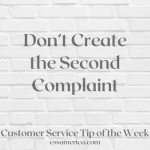“Sure I’m not sick anymore, but the food was lousy!”
Huh? Why do people go to the hospital? You would think it would be to get their broken arm healed, their sickness cured, their ailment addressed, wouldn’t you? Well you would be correct, but when patients go to hospitals, they often assume that they’ll get good clinical care. So what ends up driving their opinions of the experience is often everything BUT the clinical care.
In the article Stakes high for hospital service, Detroit-based Henry Ford health system is highlighted because of their efforts to improve patient satisfaction. The Federal Government is implementing a patient satisfaction evaluation system for healthcare providers (primarily hospitals at this point) where reimbursement will be based in part on patient satisfaction ratings. So when you don’t satisfy patients, your payments are going to suffer.
We work with hospitals, helping them create and execute 90 day action plans that focus on recognizing progress and addressing issues on an ongoing basis. The Henry Ford hospitals have gone to the point of creating “fine dining restaurant”-type menus and even creating loyalty programs for their emergency departments.
But what we find in our work with hospitals and what Henry Ford confirms is that so much of patient satisfaction comes down to whether or not employees and physicians convey they care about the patient. Is customer service part of the culture? Does the hospital care more about the patient they’re serving or the x-ray they’re taking? Are staff patient with patients, or is it more about the task than the customer?
Beyond any program you provide to your clients, first think about how you can get your employees to convey that they care for the customer. Your financial success depends on it.
Read our New Book – “Ask Yourself…Am I GREAT at Customer Service?” http://www.amigreatat.com/
Listen to our latest podcast episode of “Stepping Up Service” on The MESH Network at http://themesh.tv/stepping-up-service/
Interested in improving your company’s customer service? See more at our new website! http://www.cssamerica.com/





















